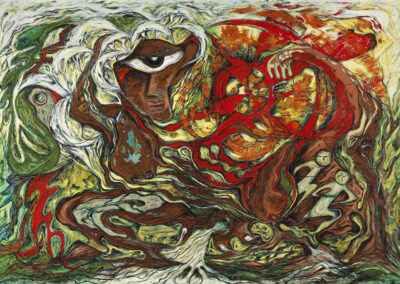Our next Artist You Need To Know is Daphne Odjig (1919 – 2016). She was a First Nations artist of Odawa-Potawatomi-English heritage. Her painting is often characterized as Woodlands Style or as the pictographic style. Odjig was the major instigator and founder of the Professional Native Indian Artists Association (often referred to as the Indian Group of Seven) which would break major ground in bringing First Nations art to the forefront of Canada’s art world, and beyond.
“I see my paintings as a celebration of life. My sub-conscious mind may well dictate some content and I’m content to leave it at that. I am uncomfortable with words – my paintings are perhaps my most honest and legitimate statement.”
-

Conflict of Good and Evil, 1966
-

Nanabush Giving the Racoon its Colours, 1969
-

Genocide No. 1, 1971
-

The Creation of the World, 1972
-

From Mother Earth Flows the River of Life, 1973
-

Vision, 1975
Odjig’s style, which “underwent several developments and adaptations from decade to decade, manages to always remain identifiable. Mixing traditional Indigenous styles and imagery with Cubist and Surrealist influences, Odjig’s work is defined by curving contours, strong outlining, overlapping shapes and an unsurpassed sense of colour. Her work has addressed issues of colonization, the displacement of Indigenous Peoples, and the status of Indigenous women and children, bringing Indigenous political issues to the forefront of contemporary art practices and theory.” (from The National Gallery of Canada)
She was born in 1919 on the Wikwemikong Reserve on Mnidoo Mnis [Spirit Island], also known as Manitoulin Island. Her artistic training began “when rheumatic fever forced her to leave school at age 13 and her grandfather Jonas, a stone carver, and father Dominic nurtured her talent for drawing. Sometimes Jonas told traditional Potawatomi stories while they sketched and painted. Though she would spend her early adulthood disconnected from her heritage – in large part an effort to avoid racism – she never stopped making art. Art would become the most significant line connecting the phases of her life.”
More from the accompanying catalogue to The Drawings and Paintings of Daphne Odjig: A Retrospective Exhibition (at the National Gallery and the Art Gallery of Sudbury, 2009 – 2010): “The stories as much as the curvilinear drawing style she learned from her stone carver grandfather during her convalescence influenced Odjig’s aesthetic and metaphysical concerns throughout her life.” (from here)
Daphne Odjig’s work is in numerous public collections, such as Canada Council’s Art Bank, the Canadian Museum of History in Gatineau, Quebec, the Tom Thomson Art Gallery, the McMichael Canadian Art Collection, the Sequoyah Research Center and the Government of Israel. Odjig has also been commissioned to create works for Expo ’70 in Osaka, Japan, the Manitoba Museum, and for El Al, the Israeli airline.
She’s been recognized with a significant number of awards and honours. These include an Honorary Doctorate of Letters from Laurentian University in 1982, an Honorary Doctorate of Law from the University of Toronto in 1985, the Order of Canada in 1986, a Commemorative Medal for the 125th Anniversary of the Confederation of Canada in 1992, an Honorary Doctorate of Education from Nipissing University in 1997, and a National Aboriginal Achievement Awards in 1998. Odjig was elected to the Royal Canadian Academy of Art in 1989, and in 2007, Odjig received the Governor General’s Award in Visual and Media Arts.
Three of her paintings have been featured as stamps with Canada Post (2011), and we’ve included an image of those below.
-

-

In My Sunday Best, n.d.
-

Visiting Grandma, 1977
-

Emerging from a Dream, n.d.
-

Mother and Child - Playtime, 1977
-

Messenger of Peace, 1991
Wanda Nanibush, an Anishinaabe curator, artist and educator who is the Curator of Indigenous Art at the Art Gallery of Ontario (and author of Violence No More: The Rise of Indigenous Women), offered the following about Odjig’s impact: “She and Alex Janvier walked out of the museum object case into the contemporary art galleries — forever changing the way Indigenous art was categorized.” (from CBC)
A tribute to Daphne Odjig’s life and work can be read here. Many more of her artworks can be enjoyed here.




















